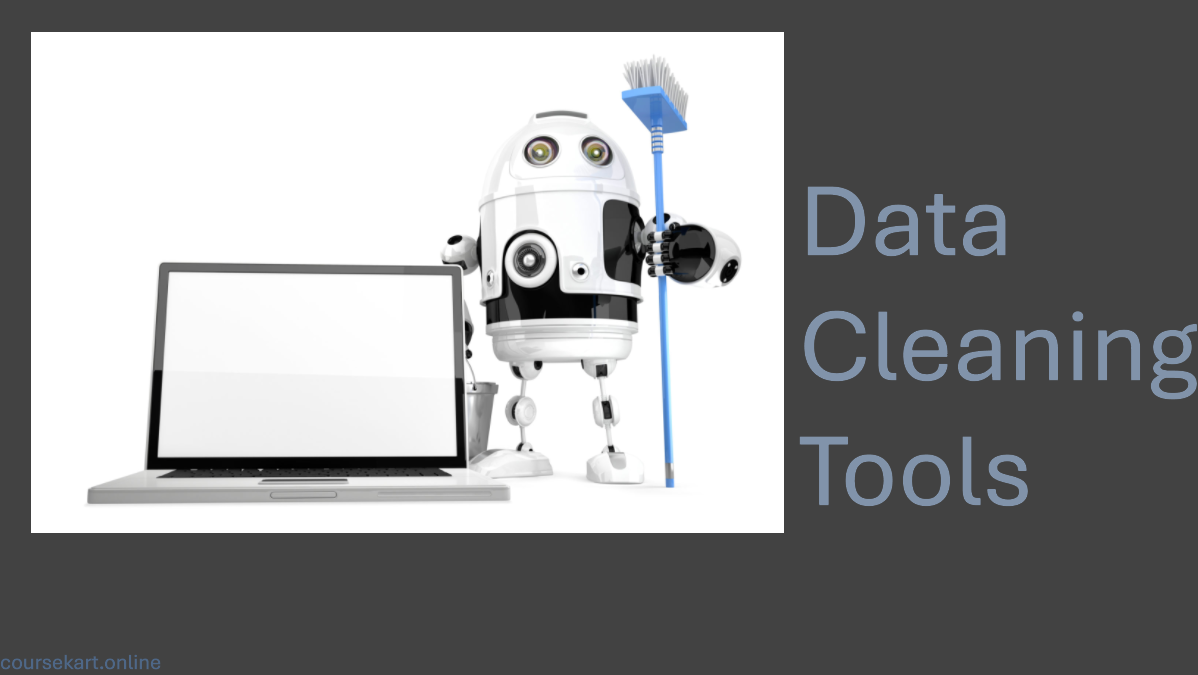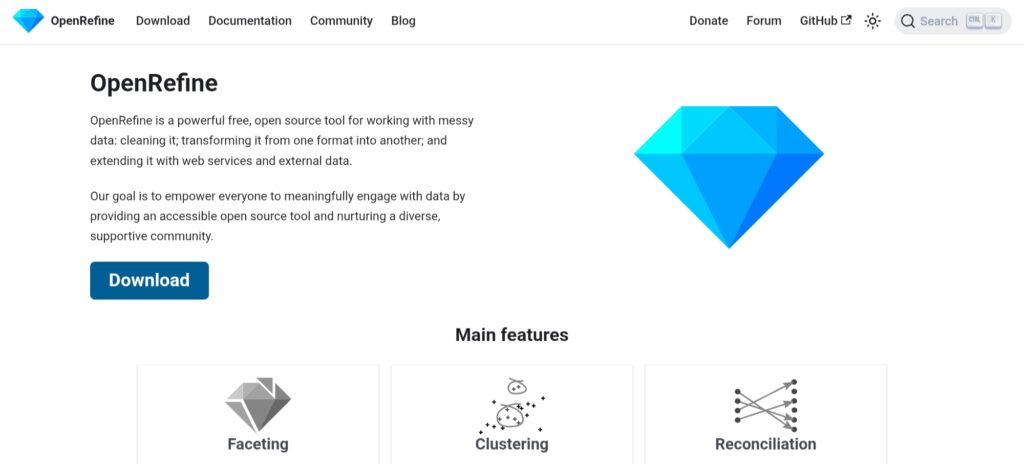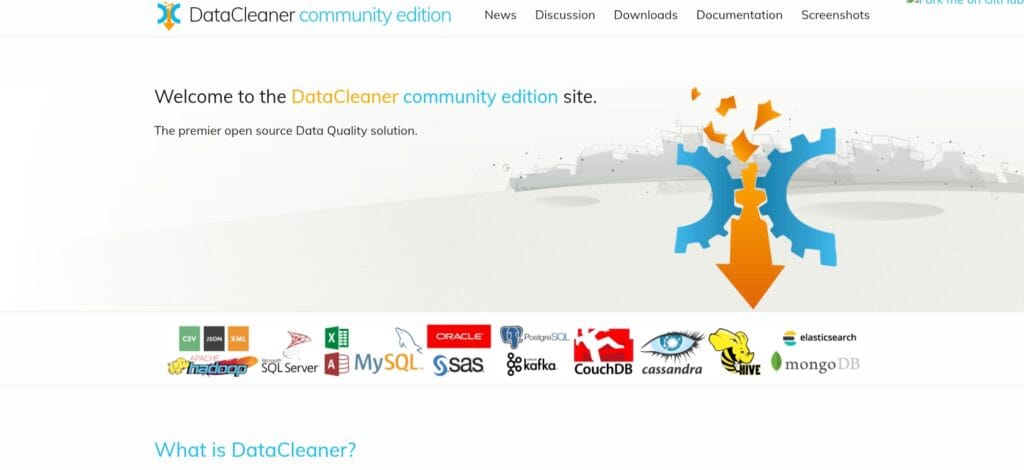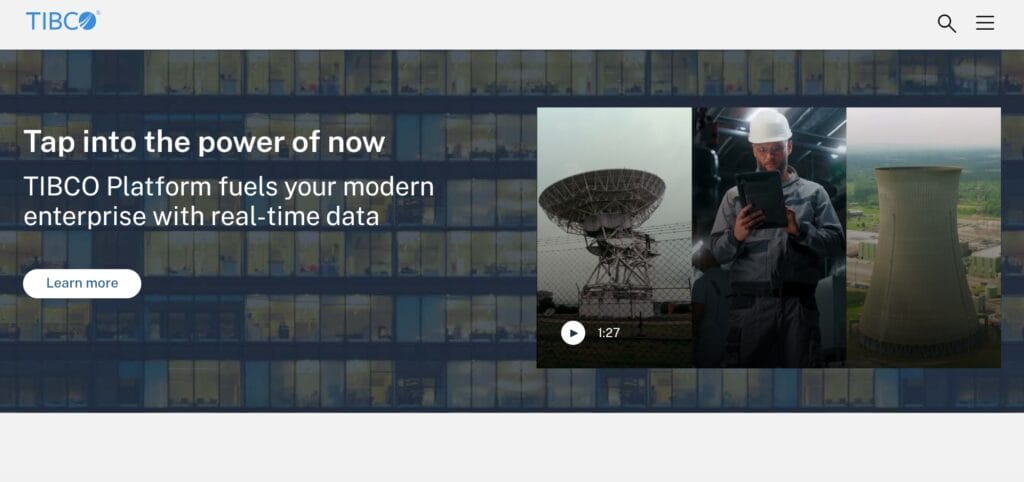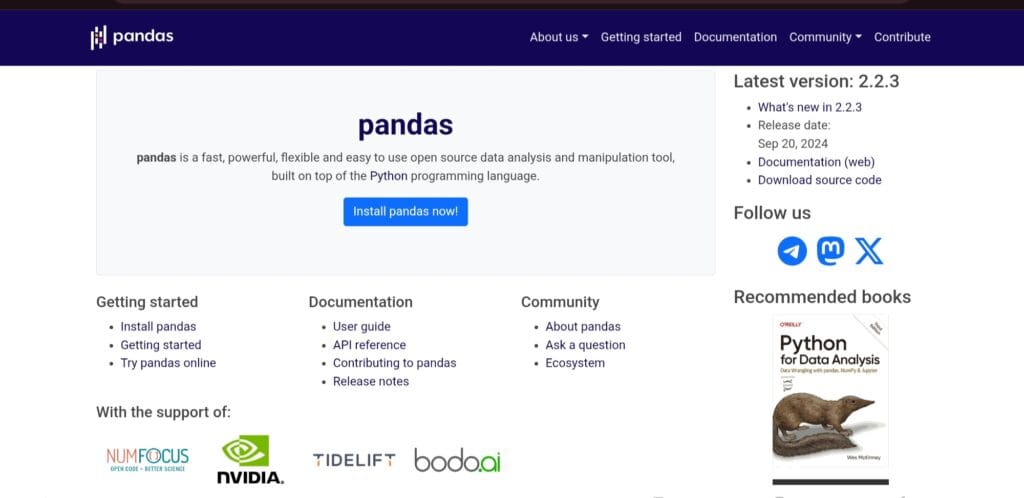In today’s data-driven environment, the quality of your insights is directly proportional to the quality of your data. While corporations acquire huge volumes of data, raw data frequently has inconsistencies, duplicates, missing values, and formatting difficulties, which can hinder analytics programs. This is when data cleansing technologies come in handy.
Data cleaning (also known as data cleansing) has progressed from laborious manual operations to sophisticated platforms that use automation and artificial intelligence. As businesses rely more on data to make strategic decisions, the need for effective data cleansing technologies has never been stronger.
According to recent industry statistics, data scientists spend between 60 and 80 percent of their time cleaning and processing data rather than extracting meaningful insights.
The good news is that modern data cleansing solutions have evolved into more intuitive, powerful, and user-friendly solutions. Whether you are a data scientist, business analyst, or IT expert, today’s market has solutions for all skill levels and organizational demands.
In this comprehensive guide, we’ll look at the top 13 data cleaning tools available in 2025, analyzing their features, strengths, limits, and best use cases to help you make an informed decision about your data preparation needs.
In this article, I will go over all of the characteristics of each program to help you compare them and choose the best one for your data cleaning adventure. So let us get started.
What Makes A Good Data Cleaning Tool?
Before delving into specific programs, it’s critical to understand what distinguishes excellent data cleaning software from inferior alternatives. Here are the main variables to consider:
- Data Profiling
The ability to automatically analyze data and detect trends, discrepancies, and quality issues without manual intervention.
- Automation Capabilities
Advanced tools provide automated detection and rectification of common data errors, saving time spent on repeated procedures.
- Integration Options
The best technologies work smoothly with a variety of data sources, storage systems, and analytics platforms.
- User Interface and Experience
Cleaning procedures are easier for users of all technical skill levels to understand because of intuitive interfaces with visual data representations.
- Scalability
Your tool should scale effectively without experiencing performance deterioration as data volumes increase.
- Transformation Features
The ability to restructure, integrate, and convert data into formats that are appropriate for analysis should be a top priority.
Free vs Paid Options
Data cleansing tools come in a variety of forms, from open-source, free options to commercial solutions that can cost thousands of dollars annually. Making the correct decision is dependent upon:
Budgetary limitations: Free or inexpensive solutions may be the first choice for organizations with little funding.
Requirements for features: Premium tools usually have advanced automation and AI capabilities.
Support requirements: Typically, only paid solutions offer enterprise-level training and support.
Scale of data: More reliable, paid solutions are frequently needed for larger data volumes.
Use Cases to Consider
Beginner-Friendly: Visual, no-code interfaces with guided workflows may be preferred by non-technical users.
Enterprise-Grade: Strong security, governance, and communication tools are essential for big businesses that handle sensitive data.
Real-Time Pipelines: To avoid batch data cleaning, some applications need technologies that can clean data in real time.
Big Data Processing: Distributed processing skills are necessary when working with large datasets.
Let’s focus on the best data cleaning solutions on the market right now while keeping these factors in mind.
Top 13 Data Cleaning Tools In 2025
1. Trifacta (now part of Alteryx)
One of the top platforms for data wrangling, Trifacta was acquired by Alteryx in 2022 and is now part of the Alteryx portfolio. Alteryx Designer Cloud, formerly known as Trifacta, offers services like pipeline development, data preparation, and data profiling.
Users are assisted by its clever visual interface in converting complex, raw data into organized, clean formats that are prepared for study.
Key Features
- Visual data profiling that identifies patterns
- Predictive transformation recommendations
- Evaluations of the visual data quality
- Architecture that is cloud-native
- Features that facilitate teamwork in cleaning
- Using machine learning to detect anomalies
- Wide-ranging connections to several data sources
Best For
Business users and data analysts who require strong cleaning capabilities without a lot of coding experience. Especially beneficial for businesses that need to regularly process data from a variety of sources.
Pricing
To find out the costs of Alteryx’s two products, Designer Cloud and Designer Desktop, one must get in touch with the sales team. Both services, however, provide a 30-day free trial so that customers can test the product before making a purchase.
Pros
- A user-friendly interface lowers the learning curve.
- Strong collaboration tools for team settings
- Intelligent recommendations speed up data preparation
- Strong data governance skills
- Outstanding at managing intricate changes
Cons
- Higher pricing compared to certain options.
- Technical expertise may be needed for advanced features.
2. OpenRefine
When it comes to open-source data cleaning technologies, OpenRefine (previously Google Refine) is still the best. This free tool works very well for text-based data cleaning tasks and is excellent at cleaning jumbled, inconsistent data.
Key Features
- Using faceted browsing to examine data
- Using cell clustering to find and address discrepancies
- Pattern matching using regular expressions and custom transformations using GEL (Google Refine Expression Language)
- Architecture extension for more functionality
- Services for reconciliation to connect data to external databases
- Capabilities for record linkage
Best For
Small to medium-sized datasets are handled by researchers, journalists, librarians, and individual analysts, particularly those that need standardization or contain text-based discrepancies.
Pricing
OpenRefine is a completely free and open-source tool for data cleansing activities.
Pros
- No expenses and no restrictions
- Strong clustering algorithms to identify comparable values
- Great for cleansing text-based data
- For the majority of activities, no code is needed.
- Active extensions and community support
Cons
- Only for datasets that are memory-compatible (usually 1GB)
- No built-in tools for collaboration
- The UI seems a little old-fashioned.
- More difficult to learn for more complex changes
3. Talend Data Preparation
Talend Data Preparation provides a drag-and-drop interface for data transformation and cleaning that is easy to use. It helps close the communication gap between IT departments and business users.
Key Features
- A user-friendly drag-and-drop interface
- Automatic identification of abnormalities and patterns in data
- Using semantic discovery to classify intelligent data
- Integrated capabilities for data quality
- Connectivity to the larger Talend ecosystem
- Governance and genealogy
- Capabilities for cooperation and sharing
Best For
Businesses looking for a complete data management platform with robust governance features, or those already utilizing Talend products. For business users who must combine IT and business needs, it works effectively.
Pricing
There are several subscription choices for Talend, including Starter, Standard, Premium, and Enterprise. For information on the costs of particular membership programs, get in touch with the sales staff of Qlik, Talend’s parent company. Additionally, you can try Talend products for free for 14 days before deciding.
Pros
- Integration with other Talend products is smooth
- Robust governance and metadata control
- Simple to use for business analysts
- Features for enterprise-level security and compliance
- The visual interface and deeper capabilities are well-balanced.
Cons
- It may be difficult to set up initially.
- Some complex functions demand technical skill.
- Infrastructure setup affects performance.
4. DataCleaner
A flexible Java-based tool for data processing, cleaning, and profiling is called DataCleaner. It offers commercial and open-source community editions with varying feature sets.
Key Features
- Complete data profiling features
- Identification and standardization of patterns
- Finding and removing duplicates
- Refer to the data matching.
- Options for automation and scheduling
- ETL transformation characteristics
- Tracking data quality indicators over time
Best For
Data engineers and technical users who require a balance between more complex settings and GUI-based activities. Especially effective for businesses that prioritize continuous data quality checking.
Pricing
To accommodate various use cases, it comes in both community and enterprise editions. Unlike the community edition, which is free, the enterprise edition has a custom price structure.
Pros
- Excellent profiling skills to find data problems
- Technical depth and visual interface are well-balanced, and personalized transformers allow for expansion.
- An effective processing engine
- Monitoring of quality over time
Cons
- Not as user-friendly for non-technical users
- The community edition offers a few features.
- In certain places, there may not be much documentation.
- Smaller community size, in contrast to other widely used tools
5. TIBCO Clarity
TIBCO Clarity (part of the TIBCO Spotfire suite) is an AI-powered data preparation solution that speeds up the cleaning process with intelligent suggestions and automation. It aims to make data cleaning more accessible to corporate users.
Key Features
- AI-enabled transformation proposals
- Smart sampling of huge datasets
- Automated data quality enhancements
- Visual data lineage.
- One-click data preparation recipes
- Self-service data preparation workflow
- Native integration with the TIBCO analytics products
Best For
Organizations that have previously invested in the TIBCO ecosystem or are prioritizing self-service data preparation for business analysts. Works well in organizations with huge and diversified datasets.
Pricing
TIBCO Clarity offers various pricing plans for various purposes. You can check the official page or contact the sales team to know the pricing details of TIBCO Clarity.
Pros
- AI-Assisted Suggestions Save significant time.
- Features an easy-to-use UI and seamless connection with TIBCO analytics.
- Smart sampling ensures good performance with massive datasets.
- Manages complex conversions with minimal user effort.
Cons
- Premium price.
- Works best within the TIBCO ecosystem.
- Some sophisticated functions require knowledge of TIBCO Spotfire.
- It can be overkill for modest data cleansing requirements.
6. Excel Power Query
Power Query (Get & Transform in recent Excel versions) has progressed from a simple Excel add-in to a robust data transformation tool integrated into Microsoft’s data solutions. It has unforeseen powerful capabilities for people who are already familiar with the Excel environment.
Key Features
- User-friendly graphical interface
- Step-by-step transformation recording
- Connects to hundreds of data sources.
- M formula language for personalized transformations
- Data profiling capabilities.
- Templates for transformations are reusable.
- Options for incremental refresh.
Best For
Excel users who must clean and transform data on a regular basis and do not want to learn new platforms. Ideal for small and medium-sized businesses that have already invested in Microsoft’s ecosystem.
Pricing
It is included with Excel, which comes with the Microsoft 365 subscription at $9 per month. Also, you can enhance its capabilities by integrating it with Microsoft Power BI Premium.
Pros
- Minimal learning curve for Excel users
- There is no additional fee for existing Excel users.
- Surprisingly strong transforming capability.
- A familiar interface decreases training needs.
- Suitable for ad-hoc cleaning jobs
Cons
- Limited to very large datasets.
- Performance problems with complex transformations
- Less collaborative compared to dedicated cleaning tools
- Weak automation capabilities in comparison to specialized platforms.
7. Apache Spark + PySpark
For enterprises dealing with large amounts of data, Apache Spark’s PySpark library provides exceptional scalability for data cleaning processes. This open-source technology allows for distributed data processing across clusters.
Key Features
- Massive scalability for large data.
- DataFrame API to do SQL-like tasks
- Machine learning library for advanced purification.
- Real-time cleaning with stream processing
- Built-in functions for standard cleaning procedures
- Integration of data lake technologies
- Support for several programming languages
Best For
Data engineers and scientists who are familiar with code-based solutions and work with massive amounts of data. Especially useful for enterprises with a current big data infrastructure.
Pricing
- Open source and free
Pros
- Unmatched scalability for large datasets.
- Economical for large-scale processing.
- Flexibility via a code-based approach
- Integration with the larger big data ecosystem
- Supports batch and streaming data cleansing.
Cons
- A steep learning curve.
- Programming knowledge is required (e.g., Python, Scala).
- Complexity of infrastructure setup and upkeep.
- Not appropriate for casual business users.
8. Alteryx Designer
Alteryx Designer provides an end-to-end analytics platform, with data cleaning being just one component of a full solution. Its no-code/low-code approach makes sophisticated data transformations available to individuals with a variety of technological expertise.
Key Features
- Visual workflow creation
- 80+ ready-made data cleanup tools
- Automated data profiling
- Advanced fuzzy matching abilities
- Integrating spatial analytics.
- Options for processing data in the database
- Templates for repetitive workflows
Best For
Business analysts and data scientists who want complete data preparation skills, along with analytics functionalities. Particularly good for businesses working with a variety of data kinds, including spatial data.
Pricing
Alteryx Designer comes in various packages for different needs and offers free trials for all packages. You can get the pricing details of the packages from the sales team of Alteryx Designer.
Pros
- Comprehensive capabilities beyond just cleaning.
- Strong automation characteristics
- Perfect for complex transformation workflows.
- Effectively manages both organized and unstructured data.
- Regular upgrades with new features
Cons
- Significant investment cost
- Resource-intensive on desktop PCs
- Complex interface with an early learning curve
9. SAS Data Quality
SAS Data Quality is an enterprise-grade solution for enterprises that have stringent data governance requirements. This program provides complete data quality control with extensive customization capabilities.
Key Features
- Enhanced data standardization capabilities
- Entity resolution and match
- Quality rule engine that can be customized
- Monitoring and alerting on data
- Integration with the SAS analytics suite
- Security and governance through role-based approaches
- Impact analysis and data lineage
Best For
Large companies have rigorous data governance procedures, especially in regulated industries such as finance, healthcare, and insurance. Ideally suited for enterprises with existing SAS investments.
Pricing
It offers enterprise pricing models for companies and has varying prices for different requirements.
Pros
- Capabilities that lead the industry in data quality
- Governance features are comprehensive.
- Highly adaptable to specific business rules.
- Excellent technical support
- Enhanced security and compliance features
Cons
- Expensive when compared to alternatives.
- Implementation is complex and requires specific skills.
- Best value when combined with other SAS solutions.
10. Pandas (Python Library)
Although it is not a stand-alone program, data scientists and analysts now consider the Pandas library for Python to be a vital resource for data cleaning. Because of its flexibility and capability, it is the preferred tool for structured data manipulation among programmers.
Related: Top Python Libraries For Data Science And Their Uses
Key Features
- Complete data structures (DataFrame, Series)
- Strong data manipulation functions
- Missing Value Handling
- Merging and joining capabilities
- Time series capabilities
- Integration with visualization libraries.
- Export/import from multiple formats.
Best For
Data scientists, analysts, and developers who are proficient with Python programming and require complete control over their data cleansing operations. It’s ideal for incorporating cleaning into bigger analytical operations.
Pricing
It is an open-source and free tool.
Pros
- Complete freedom for customized cleaning processes.
- No cost barrier to entry.
- Comprehensive community support and documentation.
- Integrates into the larger Python data science ecosystem.
- Ideal for automated and repetitive cleaning methods.
Cons
- Requires Python programming knowledge
- There is no visible interface (although tools like Jupyter can help).
- Memory constraints with really large datasets
- Limited built-in collaborative features.
- Learning curve for non-programmers.
11. IBM InfoSphere QualityStage
IBM InfoSphere QualityStage provides enterprise-level data quality management with advanced matching and standardization features. It is intended for enterprises with sophisticated data integration requirements across disparate platforms.
Key Features
- Sophisticated probabilistic matching algorithms.
- Industry-specific standardisation rules.
- Reference data management
- Investigation possibilities for rule refinement.
- Governance Integration
- Metadata-based quality evaluation
- Batch and real-time processing options
Best For
Large corporations that conduct significant data integration initiatives, particularly those involving customer or product data consolidation. Particularly useful in the banking, insurance, and healthcare industries.
Pricing
IBM InfoSphere QualityStage offers enterprise license models and custom prices for various requirements.
Pros
- Best-in-class matching capabilities
- Great for large-scale data consolidation initiatives.
- Strong governance integration.
- Proven technique that has been refined over decades
- Excellent technical assistance and expert services
Cons
- Significant investment is necessary.
- Complex implementation process.
- Requires specific expertise to maximize value.
- Less agile than the newer cloud-based options.
12. WinPure Clean & Match
WinPure Clean & Match is a user-friendly desktop application that provides specialized data deduplication and matching capabilities. This Windows-based solution focuses on providing significant data cleansing capabilities without the complexities of business platforms.
Key Features
- Fuzzy matching methods for deduplication.
- Address verification and standardization.
- Data Profiling and Validation
- Pattern-based data cleaning
- Cross-database matches
- Batch processing automation
- Excel integration
Best For
Small to medium-sized organizations that require specific deduplication capabilities without corporate complexity. Especially beneficial for marketing, sales, and customer service teams working with contact information.
Pricing
WinPure offers various plans to meet the different requirements of businesses. It has Essential, Professional, and Enterprise subscription models to suit different business needs. Also, you can try this tool for 30 days before taking a subscription.
Pros
- Specialized attention on matching and deduplication.
- Relatively economical when compared to enterprise solutions.
- Desktop-based with simple installation.
- One-time purchase instead of subscription
- Lower technological barriers to entry.
Cons
- Less appropriate for generic data transformation.
- Limited for extremely large datasets.
- Fewer integration options compared to cloud platforms.
- In comparison to newer tools, the user interface is somewhat basic.
13. Google Cloud Dataprep
Google Cloud Dataprep (powered by Trifacta) provides cloud-native data preparation capabilities, including intelligent suggestions and visual transformations. It is intended for collaborative data teams working in Google Cloud environments.
Key Features
- Intelligent transformation suggestions.
- Visual data profiling.
- Sharing collaborative projects.
- Serverless architecture for automated scaling.
- Integration of Google Cloud storage and analytics
- Detecting anomalies with machine learning
- A pay-as-you-go pricing model
Best For
Organizations using Google Cloud Platform that want easy access to data preparation tools. Especially useful for teams that need collaboration features and deal with cloud-based data.
Pricing
A free option is available for exploration, and pricing is calculated based on usage.
Pros
- No infrastructure management is required.
- Intuitive interface for non-technical users
- Strong collaborative capability.
- Integrate seamlessly with Google Cloud.
- On-demand scaling for different workloads.
Cons
- Cloud vendor lock-in worries
- Large workloads might lead to unforeseen costs.
- Internet connection required.
- Some complex functions demand technical skill.
- Limited offline capability.
Comparison Table: Data Cleaning Tools at a Glance
| Tool | Interface Type | Automation Level | Integration | Best For | Scalability |
|---|---|---|---|---|---|
| Trifacta (Alteryx) | Visual | High | Extensive | Business analysts | Medium-High |
| OpenRefine | Visual | Medium | Limited | Individual analysts | Low-Medium |
| Talend Data Preparation | Visual/Code | Medium-High | Extensive | Enterprise teams | High |
| DataCleaner | Visual/Code | Medium | Moderate | Technical analysts | Medium |
| TIBCO Clarity | Visual | High | Good within TIBCO | Business users | Medium-High |
| Excel Power Query | Visual | Low-Medium | Microsoft ecosystem | Excel users | Low-Medium |
| Apache Spark/PySpark | Code | Medium | Extensive | Data engineers | Very High |
| Alteryx Designer | Visual | High | Extensive | Analytics teams | Medium-High |
| SAS Data Quality | Visual/Code | High | SAS ecosystem | Enterprise governance | High |
| Pandas (Python) | Code | Low (manual) | Python ecosystem | Data scientists | Medium |
| IBM InfoSphere QualityStage | Visual/Code | High | IBM ecosystem | Large enterprises | High |
| WinPure Clean & Match | Visual | Medium | Limited | SMBs (contact data) | Low-Medium |
| Google Cloud Dataprep | Visual | High | Google Cloud | Cloud-based teams | High |
How to Choose the Right Data Cleaning Tool
With so many solutions available, choosing the right data cleaning tool necessitates careful analysis of your individual requirements and limitations. Here’s a realistic way to make this decision:
Define Your Data Sources And Goals
Before reviewing tools, make sure you understand:
- Data Volume: How much data will you be processing on a regular basis?
- Data Complexity: What kinds of challenges do your data normally have?
- Source Systems: Where does your information come from?
- Destination Systems: How will the cleaned data be utilized?
- Business Objectives: What specific data quality issues are you attempting to address?
Understanding these characteristics will assist you in narrowing down tools that meet your technical needs and business objectives.
Consider Your Team’s Tech Stack and Expertise
The most powerful tool will not add value if your staff is unable to use it properly. Evaluate:
- Technical Expertise: Does your staff have programming abilities, or do they require visual interfaces?
- Existing Investments: Which platforms and technologies are currently in use?
- Learning Curve: How quickly does your staff need to become productive with the new tool?
- What training and support resources are available? For teams with minimal technical resources, visual tools like Trifacta or Excel Power Query may be more appropriate than code-based solutions like Apache Spark or Pandas.
Free Trial and Demo Importance
Almost every commercial data cleaning product provides free samples or demonstrations. These are indispensable for:
- Testing using real data: Perform sample cleaning processes on your actual datasets.
- User experience evaluation: Allow potential users to test the interface.
- Performance assessment: Evaluate the speed and efficiency of normal workloads.
- Support quality: Communicate with the vendor’s support team.
A 14-30 day trial period can uncover compatibility difficulties or restrictions that are not obvious from marketing materials alone.
Additional Considerations
When choosing a data quality solution, it is critical to look beyond basic capabilities and examine larger variables that influence long-term success and fit your business.
One of the first things you should think about is deployment options. Depending on your infrastructure and security needs, you may want an on-premises arrangement, a completely cloud-based solution, or a hybrid model that balances control and flexibility. Each option has ramifications for integration, cost, and access.
Regulatory compliance is another crucial element, particularly in businesses such as healthcare, finance, and government. Check that any technology you use meets applicable data management requirements, such as GDPR, HIPAA, or industry-specific mandates. This not only helps to prevent legal problems but also promotes trust and transparency.
Consider your collaboration needs as well. If numerous team members or departments will be involved in data cleansing and quality management, the application should allow for shared workflows, version control, and unambiguous role-based permissions. Collaboration features can improve efficiency and reduce the likelihood of errors.
As your company grows, your data requirements will most certainly increase. Assess the tool’s scalability to ensure that it can handle growing data volume, complexity, and user demands. A solution that works for a small team today may not be adequate in a year or two if expansion is not taken into consideration.
Finally, examine your total cost of ownership (TCO). Licensing payments are only one part of the picture. Include costs for deployment, personnel training, technical support, and ongoing maintenance. A lower upfront price may be countered by greater long-term expenses, therefore, it is critical to consider the total investment.
Final Thoughts
The field of data cleaning tools is continuously evolving, fueled by artificial intelligence, cloud computing, and the growing democratization of data processing. As we’ve seen throughout this overview, there is no one-size-fits-all solution; the best option relies on your individual needs, technical environment, and organizational context.
I hope this thorough article has given you some ideas and the necessary information you need to select the appropriate data cleaning tool for your data management goals. Let me know in the comments if you have anything to say on this.
Note: This thorough guide was created after conducting significant study and gaining practical expertise with data cleansing technologies in a variety of sectors and use cases. Our team continuously reviews developing technologies and best practices to assist organizations in navigating the complicated environment of data management solutions.
FAQ
What is data cleaning, and why is it important?
Data cleaning is the process of identifying, correcting, or eliminating erroneous, incomplete, or irrelevant data from a dataset. It is critical because low-quality data can lead to inaccurate analysis, projections, and business decisions.
Which are the best free data cleaning tools for beginners?
Which are the best free data cleaning tools for beginners?Some of the finest free tools for novices are OpenRefine, Excel Power Query, and Pandas (Python). These tools provide an excellent balance of simplicity and capability, making them suitable for learning and modest projects.
Are there any cloud-based data cleaning tools?
Yes, solutions such as Google Cloud Dataprep and Trifacta (Alteryx Designer Cloud) provide cloud-based data cleaning. They excel at teamwork and can manage large-scale data preparation tasks.
What is the difference between data cleaning and data transformation?
Data cleaning entails removing mistakes and inconsistencies, whereas data transformation entails modifying the format or structure of data (for example, normalizing, aggregating, and encoding). Many tools include both as part of their data preparation workflow.
Do I need coding skills to use data cleaning tools?
Not necessarily. Tools such as Talend, Alteryx, and WinPure provide drag-and-drop interfaces that do not require code. If you are acquainted with programming, coding tools like Pandas or PySpark can provide extra flexibility for difficult jobs.
How do I choose the right data cleaning tool for my needs?
Consider your budget, technical abilities, data size, and the type of data you are dealing with. Beginners may prefer graphical interfaces, but advanced users may benefit from script-based tools such as Pandas or Spark.
Share Now:
Related Articles
The Importance of Data Cleaning and How to Do It Effectively?
The Data Science Toolkit: 12 Most Used Data Science Tools Every Data Scientist Needs to Know
How to Visualize Data Like a Pro? Smart Strategies for Clear and Impactful Insights
Discover more from coursekart.online
Subscribe to get the latest posts sent to your email.

